| Listing 1 - 10 of 12 | << page >> |
Sort by
|
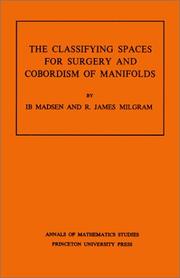
ISBN: 0691082251 069108226X 1400881471 Year: 1979 Publisher: Princeton : Tokyo : Princeton University Press Tokyo university press,
Abstract | Keywords | Export | Availability | Bookmark
 Loading...
Loading...Choose an application
- Reference Manager
- EndNote
- RefWorks (Direct export to RefWorks)
Beginning with a general discussion of bordism, Professors Madsen and Milgram present the homotopy theory of the surgery classifying spaces and the classifying spaces for the various required bundle theories. The next part covers more recent work on the maps between these spaces and the properties of the PL and Top characteristic classes, and includes integrality theorems for topological and PL manifolds. Later chapters treat the integral cohomology of BPL and Btop. The authors conclude with a discussion of the PL and topological cobordism rings and a construction of the torsion-free generators.
Algebraic topology --- 515.16 --- Classifying spaces --- Cobordism theory --- Manifolds (Mathematics) --- Surgery (Topology) --- Differential topology --- Homotopy equivalences --- Topology --- Geometry, Differential --- Spaces, Classifying --- Fiber bundles (Mathematics) --- Fiber spaces (Mathematics) --- Topology of manifolds --- Classifying spaces. --- Cobordism theory. --- Manifolds (Mathematics). --- Surgery (Topology). --- 515.16 Topology of manifolds --- Bijection. --- Calculation. --- Characteristic class. --- Classification theorem. --- Classifying space. --- Closed manifold. --- Cobordism. --- Coefficient. --- Cohomology. --- Commutative diagram. --- Commutative property. --- Complex projective space. --- Connected sum. --- Corollary. --- Cup product. --- Diagram (category theory). --- Differentiable manifold. --- Disjoint union. --- Disk (mathematics). --- Effective method. --- Eilenberg–Moore spectral sequence. --- Elaboration. --- Equivalence class. --- Exact sequence. --- Exterior algebra. --- Fiber bundle. --- Fibration. --- Function composition. --- H-space. --- Homeomorphism. --- Homomorphism. --- Homotopy fiber. --- Homotopy group. --- Homotopy. --- Hopf algebra. --- Iterative method. --- Loop space. --- Manifold. --- Massey product. --- N-sphere. --- Normal bundle. --- Obstruction theory. --- Pairing. --- Permutation. --- Piecewise linear manifold. --- Piecewise linear. --- Polynomial. --- Prime number. --- Projective space. --- Sequence. --- Simply connected space. --- Special case. --- Spin structure. --- Steenrod algebra. --- Subset. --- Summation. --- Tensor product. --- Theorem. --- Topological group. --- Topological manifold. --- Topology. --- Total order. --- Variétés topologiques --- Topologie differentielle
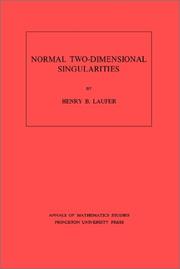
ISBN: 069108100X 1400881749 9780691081007 Year: 1971 Volume: 71 Publisher: Princeton : Princeton University Press,
Abstract | Keywords | Export | Availability | Bookmark
 Loading...
Loading...Choose an application
- Reference Manager
- EndNote
- RefWorks (Direct export to RefWorks)
A survey, thorough and timely, of the singularities of two-dimensional normal complex analytic varieties, the volume summarizes the results obtained since Hirzebruch's thesis (1953) and presents new contributions. First, the singularity is resolved and shown to be classified by its resolution; then, resolutions are classed by the use of spaces with nilpotents; finally, the spaces with nilpotents are determined by means of the local ring structure of the singularity.
Algebraic geometry --- Analytic spaces --- SINGULARITIES (Mathematics) --- 512.76 --- Singularities (Mathematics) --- Geometry, Algebraic --- Spaces, Analytic --- Analytic functions --- Functions of several complex variables --- Birational geometry. Mappings etc. --- Analytic spaces. --- Singularities (Mathematics). --- 512.76 Birational geometry. Mappings etc. --- Birational geometry. Mappings etc --- Analytic function. --- Analytic set. --- Analytic space. --- Automorphism. --- Bernhard Riemann. --- Big O notation. --- Calculation. --- Chern class. --- Codimension. --- Coefficient. --- Cohomology. --- Compact Riemann surface. --- Complex manifold. --- Computation. --- Connected component (graph theory). --- Continuous function. --- Contradiction. --- Coordinate system. --- Corollary. --- Covering space. --- Dimension. --- Disjoint union. --- Divisor. --- Dual graph. --- Elliptic curve. --- Elliptic function. --- Embedding. --- Existential quantification. --- Factorization. --- Fiber bundle. --- Finite set. --- Formal power series. --- Hausdorff space. --- Holomorphic function. --- Homeomorphism. --- Homology (mathematics). --- Intersection (set theory). --- Intersection number (graph theory). --- Inverse limit. --- Irreducible component. --- Isolated singularity. --- Iteration. --- Lattice (group). --- Line bundle. --- Linear combination. --- Line–line intersection. --- Local coordinates. --- Local ring. --- Mathematical induction. --- Maximal ideal. --- Meromorphic function. --- Monic polynomial. --- Nilpotent. --- Normal bundle. --- Open set. --- Parameter. --- Plane curve. --- Pole (complex analysis). --- Power series. --- Presheaf (category theory). --- Projective line. --- Quadratic transformation. --- Quantity. --- Riemann surface. --- Riemann–Roch theorem. --- Several complex variables. --- Submanifold. --- Subset. --- Tangent bundle. --- Tangent space. --- Tensor algebra. --- Theorem. --- Topological space. --- Transition function. --- Two-dimensional space. --- Variable (mathematics). --- Zero divisor. --- Zero of a function. --- Zero set. --- Variétés complexes --- Espaces analytiques
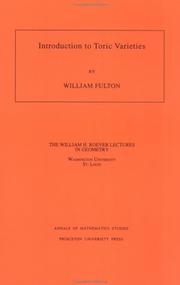
ISBN: 0691000492 0691033323 1400882524 Year: 1993 Publisher: Princeton Princeton university press
Abstract | Keywords | Export | Availability | Bookmark
 Loading...
Loading...Choose an application
- Reference Manager
- EndNote
- RefWorks (Direct export to RefWorks)
Toric varieties are algebraic varieties arising from elementary geometric and combinatorial objects such as convex polytopes in Euclidean space with vertices on lattice points. Since many algebraic geometry notions such as singularities, birational maps, cycles, homology, intersection theory, and Riemann-Roch translate into simple facts about polytopes, toric varieties provide a marvelous source of examples in algebraic geometry. In the other direction, general facts from algebraic geometry have implications for such polytopes, such as to the problem of the number of lattice points they contain. In spite of the fact that toric varieties are very special in the spectrum of all algebraic varieties, they provide a remarkably useful testing ground for general theories. The aim of this mini-course is to develop the foundations of the study of toric varieties, with examples, and describe some of these relations and applications. The text concludes with Stanley's theorem characterizing the numbers of simplicies in each dimension in a convex simplicial polytope. Although some general theorems are "ed without proof, the concrete interpretations via simplicial geometry should make the text accessible to beginners in algebraic geometry.
Algebraic geometry --- Differential geometry. Global analysis --- 512.7 --- Algebraic geometry. Commutative rings and algebras --- Toric varieties. --- 512.7 Algebraic geometry. Commutative rings and algebras --- Toric varieties --- Embeddings, Torus --- Torus embeddings --- Varieties, Toric --- Algebraic varieties --- Addition. --- Affine plane. --- Affine space. --- Affine variety. --- Alexander Grothendieck. --- Alexander duality. --- Algebraic curve. --- Algebraic group. --- Atiyah–Singer index theorem. --- Automorphism. --- Betti number. --- Big O notation. --- Characteristic class. --- Chern class. --- Chow group. --- Codimension. --- Cohomology. --- Combinatorics. --- Commutative property. --- Complete intersection. --- Convex polytope. --- Convex set. --- Coprime integers. --- Cotangent space. --- Dedekind sum. --- Dimension (vector space). --- Dimension. --- Direct proof. --- Discrete valuation ring. --- Discrete valuation. --- Disjoint union. --- Divisor (algebraic geometry). --- Divisor. --- Dual basis. --- Dual space. --- Equation. --- Equivalence class. --- Equivariant K-theory. --- Euler characteristic. --- Exact sequence. --- Explicit formula. --- Facet (geometry). --- Fundamental group. --- Graded ring. --- Grassmannian. --- H-vector. --- Hirzebruch surface. --- Hodge theory. --- Homogeneous coordinates. --- Homomorphism. --- Hypersurface. --- Intersection theory. --- Invertible matrix. --- Invertible sheaf. --- Isoperimetric inequality. --- Lattice (group). --- Leray spectral sequence. --- Limit point. --- Line bundle. --- Line segment. --- Linear subspace. --- Local ring. --- Mathematical induction. --- Mixed volume. --- Moduli space. --- Moment map. --- Monotonic function. --- Natural number. --- Newton polygon. --- Open set. --- Picard group. --- Pick's theorem. --- Polytope. --- Projective space. --- Quadric. --- Quotient space (topology). --- Regular sequence. --- Relative interior. --- Resolution of singularities. --- Restriction (mathematics). --- Resultant. --- Riemann–Roch theorem. --- Serre duality. --- Sign (mathematics). --- Simplex. --- Simplicial complex. --- Simultaneous equations. --- Spectral sequence. --- Subgroup. --- Subset. --- Summation. --- Surjective function. --- Tangent bundle. --- Theorem. --- Topology. --- Toric variety. --- Unit disk. --- Vector space. --- Weil conjecture. --- Zariski topology.
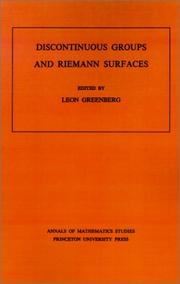
ISBN: 0691081387 1400881641 9780691081380 Year: 1974 Volume: 79 Publisher: Princeton : Princeton University Press,
Abstract | Keywords | Export | Availability | Bookmark
 Loading...
Loading...Choose an application
- Reference Manager
- EndNote
- RefWorks (Direct export to RefWorks)
Study 79 contains a collection of papers presented at the Conference on Discontinuous Groups and Ricmann Surfaces at the University of Maryland, May 21-25, 1973. The papers, by leading authorities, deal mainly with Fuchsian and Kleinian groups, Teichmüller spaces, Jacobian varieties, and quasiconformal mappings. These topics are intertwined, representing a common meeting of algebra, geometry, and analysis.
Group theory --- Complex analysis --- Number theory --- RIEMANN SURFACES --- Discontinuous groups --- congresses --- Congresses --- Riemann surfaces --- Congresses. --- Groupes discontinus --- Combinatorial topology --- Functions of complex variables --- Surfaces, Riemann --- Functions --- Abelian variety. --- Adjunction (field theory). --- Affine space. --- Algebraic curve. --- Algebraic structure. --- Analytic function. --- Arithmetic genus. --- Automorphism. --- Bernhard Riemann. --- Boundary (topology). --- Cauchy sequence. --- Cauchy–Schwarz inequality. --- Cayley–Hamilton theorem. --- Closed geodesic. --- Combination. --- Commutative diagram. --- Commutator subgroup. --- Compact Riemann surface. --- Complex dimension. --- Complex manifold. --- Complex multiplication. --- Complex space. --- Complex torus. --- Congruence subgroup. --- Conjugacy class. --- Convex set. --- Cyclic group. --- Degeneracy (mathematics). --- Diagram (category theory). --- Diffeomorphism. --- Differential form. --- Dimension (vector space). --- Disjoint sets. --- E7 (mathematics). --- Endomorphism. --- Equation. --- Equivalence class. --- Euclidean space. --- Existence theorem. --- Existential quantification. --- Finite group. --- Finitely generated group. --- Fuchsian group. --- Fundamental domain. --- Fundamental lemma (Langlands program). --- Fundamental polygon. --- Galois extension. --- Holomorphic function. --- Homeomorphism. --- Homology (mathematics). --- Homomorphism. --- Hurwitz's theorem (number theory). --- Inclusion map. --- Inequality (mathematics). --- Inner automorphism. --- Intersection (set theory). --- Irreducibility (mathematics). --- Isomorphism class. --- Isomorphism theorem. --- Jacobian variety. --- Jordan curve theorem. --- Kleinian group. --- Limit point. --- Mapping class group. --- Metric space. --- Monodromy. --- Monomorphism. --- Möbius transformation. --- Non-Euclidean geometry. --- Orthogonal trajectory. --- Permutation. --- Polynomial. --- Power series. --- Projective variety. --- Quadratic differential. --- Quadric. --- Quasi-projective variety. --- Quasiconformal mapping. --- Quotient space (topology). --- Rectangle. --- Riemann mapping theorem. --- Riemann surface. --- Schwarzian derivative. --- Simply connected space. --- Simultaneous equations. --- Special case. --- Subgroup. --- Subsequence. --- Surjective function. --- Symmetric space. --- Tangent space. --- Teichmüller space. --- Theorem. --- Topological space. --- Topology. --- Uniqueness theorem. --- Unit disk. --- Variable (mathematics). --- Winding number. --- Word problem (mathematics). --- RIEMANN SURFACES - congresses --- Discontinuous groups - Congresses --- Geometrie algebrique --- Fonctions d'une variable complexe --- Surfaces de riemann
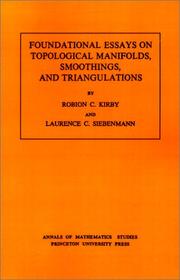
ISBN: 0691081905 0691081913 1400881501 9780691081908 Year: 1977 Volume: no. 88 Publisher: Princeton : Tokyo : Princeton University Press University of Tokyo press,
Abstract | Keywords | Export | Availability | Bookmark
 Loading...
Loading...Choose an application
- Reference Manager
- EndNote
- RefWorks (Direct export to RefWorks)
Since Poincaré's time, topologists have been most concerned with three species of manifold. The most primitive of these--the TOP manifolds--remained rather mysterious until 1968, when Kirby discovered his now famous torus unfurling device. A period of rapid progress with TOP manifolds ensued, including, in 1969, Siebenmann's refutation of the Hauptvermutung and the Triangulation Conjecture. Here is the first connected account of Kirby's and Siebenmann's basic research in this area.The five sections of this book are introduced by three articles by the authors that initially appeared between 1968 and 1970. Appendices provide a full discussion of the classification of homotopy tori, including Casson's unpublished work and a consideration of periodicity in topological surgery.
Differential geometry. Global analysis --- Manifolds (Mathematics) --- Piecewise linear topology --- Triangulating manifolds --- Variétés (Mathématiques) --- Topologie linéaire par morceaux --- 515.16 --- Manifolds, Triangulating --- PL topology --- Topology --- Geometry, Differential --- Topology of manifolds --- Piecewise linear topology. --- Triangulating manifolds. --- Manifolds (Mathematics). --- 515.16 Topology of manifolds --- Variétés (Mathématiques) --- Topologie linéaire par morceaux --- Triangulation. --- Triangulation --- Affine space. --- Algebraic topology (object). --- Approximation. --- Associative property. --- Automorphism. --- Big O notation. --- CW complex. --- Calculation. --- Cap product. --- Cartesian product. --- Category of sets. --- Chain complex. --- Classification theorem. --- Classifying space. --- Cobordism. --- Codimension. --- Cofibration. --- Cohomology. --- Connected space. --- Continuous function (set theory). --- Continuous function. --- Counterexample. --- Diffeomorphism. --- Differentiable manifold. --- Differential structure. --- Differential topology. --- Dimension (vector space). --- Direct proof. --- Disjoint union. --- Elementary proof. --- Embedding. --- Euclidean space. --- Existence theorem. --- Existential quantification. --- Fiber bundle. --- Fibration. --- General position. --- Geometry. --- Group homomorphism. --- H-cobordism. --- H-space. --- Handle decomposition. --- Handlebody. --- Hauptvermutung. --- Hausdorff space. --- Hilbert cube. --- Homeomorphism group. --- Homeomorphism. --- Homomorphism. --- Homotopy group. --- Homotopy. --- Inclusion map. --- Injective function. --- Invertible matrix. --- K-cell (mathematics). --- Kan extension. --- Linear subspace. --- Linear topology. --- Manifold. --- Mapping cylinder. --- Mathematical induction. --- Mathematician. --- Metric space. --- Morse theory. --- Neighbourhood (mathematics). --- Open set. --- Partition of unity. --- Piecewise linear manifold. --- Piecewise linear. --- Poincaré conjecture. --- Polyhedron. --- Principal bundle. --- Product metric. --- Pushout (category theory). --- Regular homotopy. --- Retract. --- Sheaf (mathematics). --- Simplicial complex. --- Smoothing. --- Spin structure. --- Stability theory. --- Stable manifold. --- Standard map. --- Submanifold. --- Submersion (mathematics). --- Subset. --- Surgery exact sequence. --- Surjective function. --- Theorem. --- Topological group. --- Topological manifold. --- Topological space. --- Topology. --- Transversal (geometry). --- Transversality (mathematics). --- Transversality theorem. --- Union (set theory). --- Uniqueness theorem. --- Vector bundle. --- Zorn's lemma. --- Variétés topologiques
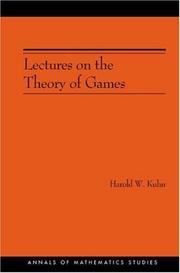
ISBN: 0691027714 0691027722 9786612159114 1282159119 1400829569 9781400829569 9781282159112 6612159111 9780691027715 9780691027722 Year: 2003 Volume: 37 Publisher: Princeton, N.J. : Princeton University Press,
Abstract | Keywords | Export | Availability | Bookmark
 Loading...
Loading...Choose an application
- Reference Manager
- EndNote
- RefWorks (Direct export to RefWorks)
This book is a spectacular introduction to the modern mathematical discipline known as the Theory of Games. Harold Kuhn first presented these lectures at Princeton University in 1952. They succinctly convey the essence of the theory, in part through the prism of the most exciting developments at its frontiers half a century ago. Kuhn devotes considerable space to topics that, while not strictly the subject matter of game theory, are firmly bound to it. These are taken mainly from the geometry of convex sets and the theory of probability distributions. The book opens by addressing "matrix games," a name first introduced in these lectures as an abbreviation for two-person, zero-sum games in normal form with a finite number of pure strategies. It continues with a treatment of games in extensive form, using a model introduced by the author in 1950 that quickly supplanted von Neumann and Morgenstern's cumbersome approach. A final section deals with games that have an infinite number of pure strategies for the two players. Throughout, the theory is generously illustrated with examples, and exercises test the reader's understanding. A historical note caps off each chapter. For readers familiar with the calculus and with elementary matrix theory or vector analysis, this book offers an indispensable store of vital insights on a subject whose importance has only grown with the years.
Operational research. Game theory --- Game theory --- 519.83 --- Theory of games --- 519.83 Theory of games --- Game theory. --- Games, Theory of --- Mathematical models --- Mathematics --- Abstract algebra. --- Addition. --- Algorithm. --- Almost surely. --- Analytic geometry. --- Axiom. --- Basic solution (linear programming). --- Big O notation. --- Bijection. --- Binary relation. --- Boundary (topology). --- Bounded set (topological vector space). --- Branch point. --- Calculation. --- Cardinality of the continuum. --- Cardinality. --- Cartesian coordinate system. --- Characteristic function (probability theory). --- Combination. --- Computation. --- Connectivity (graph theory). --- Constructive proof. --- Convex combination. --- Convex function. --- Convex hull. --- Convex set. --- Coordinate system. --- David Gale. --- Diagram (category theory). --- Differential equation. --- Dimension (vector space). --- Dimensional analysis. --- Disjoint sets. --- Distribution function. --- Embedding. --- Empty set. --- Enumeration. --- Equation. --- Equilibrium point. --- Equivalence relation. --- Estimation. --- Euclidean space. --- Existential quantification. --- Expected loss. --- Extreme point. --- Formal scheme. --- Fundamental theorem. --- Galois theory. --- Geometry. --- Hyperplane. --- Inequality (mathematics). --- Infimum and supremum. --- Integer. --- Iterative method. --- Line segment. --- Linear equation. --- Linear inequality. --- Matching Pennies. --- Mathematical induction. --- Mathematical optimization. --- Mathematical theory. --- Mathematician. --- Mathematics. --- Matrix (mathematics). --- Measure (mathematics). --- Min-max theorem. --- Minimum distance. --- Mutual exclusivity. --- Prediction. --- Probability distribution. --- Probability interpretations. --- Probability measure. --- Probability theory. --- Probability. --- Proof by contradiction. --- Quantity. --- Rank (linear algebra). --- Rational number. --- Real number. --- Requirement. --- Scientific notation. --- Sign (mathematics). --- Solution set. --- Special case. --- Statistics. --- Strategist. --- Strategy (game theory). --- Subset. --- Theorem. --- Theory of Games and Economic Behavior. --- Theory. --- Three-dimensional space (mathematics). --- Total order. --- Two-dimensional space. --- Union (set theory). --- Unit interval. --- Unit square. --- Vector Analysis. --- Vector calculus. --- Vector space.
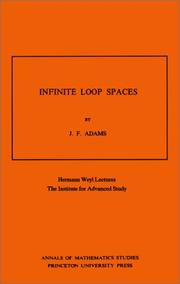
ISBN: 0691082073 0691082065 1400821258 Year: 1978 Volume: no. 90 Publisher: Princeton : Tokyo : Princeton University Press University of Tokyo press,
Abstract | Keywords | Export | Availability | Bookmark
 Loading...
Loading...Choose an application
- Reference Manager
- EndNote
- RefWorks (Direct export to RefWorks)
The theory of infinite loop spaces has been the center of much recent activity in algebraic topology. Frank Adams surveys this extensive work for researchers and students. Among the major topics covered are generalized cohomology theories and spectra; infinite-loop space machines in the sense of Boadman-Vogt, May, and Segal; localization and group completion; the transfer; the Adams conjecture and several proofs of it; and the recent theories of Adams and Priddy and of Madsen, Snaith, and Tornehave.
Algebraic topology --- Loop spaces --- Espaces de lacets --- Infinite loop spaces. --- Abelian group. --- Adams spectral sequence. --- Adjoint functors. --- Algebraic K-theory. --- Algebraic topology. --- Automorphism. --- Axiom. --- Bott periodicity theorem. --- CW complex. --- Calculation. --- Cartesian product. --- Cobordism. --- Coefficient. --- Cofibration. --- Cohomology operation. --- Cohomology ring. --- Cohomology. --- Commutative diagram. --- Continuous function. --- Counterexample. --- De Rham cohomology. --- Diagram (category theory). --- Differentiable manifold. --- Dimension. --- Discrete space. --- Disjoint union. --- Double coset. --- Eilenberg. --- Eilenberg–Steenrod axioms. --- Endomorphism. --- Epimorphism. --- Equivalence class. --- Euler class. --- Existential quantification. --- Explicit formulae (L-function). --- Exterior algebra. --- F-space. --- Fiber bundle. --- Fibration. --- Finite group. --- Function composition. --- Function space. --- Functor. --- Fundamental class. --- Fundamental group. --- Geometry. --- H-space. --- Homology (mathematics). --- Homomorphism. --- Homotopy category. --- Homotopy group. --- Homotopy. --- Hurewicz theorem. --- Inverse limit. --- J-homomorphism. --- K-theory. --- Limit (mathematics). --- Loop space. --- Mathematical induction. --- Maximal torus. --- Module (mathematics). --- Monoid. --- Monoidal category. --- Moore space. --- Morphism. --- Multiplication. --- Natural transformation. --- P-adic number. --- P-complete. --- Parameter space. --- Permutation. --- Prime number. --- Principal bundle. --- Principal ideal domain. --- Pullback (category theory). --- Quotient space (topology). --- Reduced homology. --- Riemannian manifold. --- Ring spectrum. --- Serre spectral sequence. --- Simplicial set. --- Simplicial space. --- Special case. --- Spectral sequence. --- Stable homotopy theory. --- Steenrod algebra. --- Subalgebra. --- Subring. --- Subset. --- Surjective function. --- Theorem. --- Theory. --- Topological K-theory. --- Topological ring. --- Topological space. --- Topology. --- Universal bundle. --- Universal coefficient theorem. --- Vector bundle. --- Weak equivalence (homotopy theory). --- Topologie algébrique
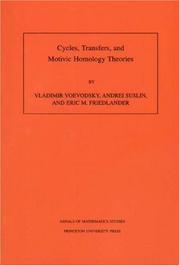
ISBN: 0691048142 0691048150 9786613379825 1283379821 140083712X 9780691048147 9780691048154 Year: 2011 Volume: 143 Publisher: Princeton, NJ : Princeton University Press,
Abstract | Keywords | Export | Availability | Bookmark
 Loading...
Loading...Choose an application
- Reference Manager
- EndNote
- RefWorks (Direct export to RefWorks)
The original goal that ultimately led to this volume was the construction of "motivic cohomology theory," whose existence was conjectured by A. Beilinson and S. Lichtenbaum. This is achieved in the book's fourth paper, using results of the other papers whose additional role is to contribute to our understanding of various properties of algebraic cycles. The material presented provides the foundations for the recent proof of the celebrated "Milnor Conjecture" by Vladimir Voevodsky. The theory of sheaves of relative cycles is developed in the first paper of this volume. The theory of presheaves with transfers and more specifically homotopy invariant presheaves with transfers is the main theme of the second paper. The Friedlander-Lawson moving lemma for families of algebraic cycles appears in the third paper in which a bivariant theory called bivariant cycle cohomology is constructed. The fifth and last paper in the volume gives a proof of the fact that bivariant cycle cohomology groups are canonically isomorphic (in appropriate cases) to Bloch's higher Chow groups, thereby providing a link between the authors' theory and Bloch's original approach to motivic (co-)homology.
Bundeltheorie --- Cohomology [Sheaf ] --- Faisceaux [Théorie des ] --- Sheaf cohomology --- Sheaf theory --- Sheaves (Algebraic topology) --- Sheaves [Theory of ] --- Théorie des faisceaux --- Algebraic cycles --- Homology theory --- Algebraic cycles. --- Homology theory. --- Cohomology theory --- Contrahomology theory --- Algebraic topology --- Cycles, Algebraic --- Geometry, Algebraic --- Abelian category. --- Abelian group. --- Addition. --- Additive category. --- Adjoint functors. --- Affine space. --- Affine variety. --- Alexander Grothendieck. --- Algebraic K-theory. --- Algebraic cycle. --- Algebraically closed field. --- Andrei Suslin. --- Associative property. --- Base change. --- Category of abelian groups. --- Chain complex. --- Chow group. --- Closed immersion. --- Codimension. --- Coefficient. --- Cohomology. --- Cokernel. --- Commutative property. --- Commutative ring. --- Compactification (mathematics). --- Comparison theorem. --- Computation. --- Connected component (graph theory). --- Connected space. --- Corollary. --- Diagram (category theory). --- Dimension. --- Discrete valuation ring. --- Disjoint union. --- Divisor. --- Embedding. --- Endomorphism. --- Epimorphism. --- Exact sequence. --- Existential quantification. --- Field of fractions. --- Functor. --- Generic point. --- Geometry. --- Grothendieck topology. --- Homeomorphism. --- Homogeneous coordinates. --- Homology (mathematics). --- Homomorphism. --- Homotopy category. --- Homotopy. --- Injective sheaf. --- Irreducible component. --- K-theory. --- Mathematical induction. --- Mayer–Vietoris sequence. --- Milnor K-theory. --- Monoid. --- Monoidal category. --- Monomorphism. --- Morphism of schemes. --- Morphism. --- Motivic cohomology. --- Natural transformation. --- Nisnevich topology. --- Noetherian. --- Open set. --- Pairing. --- Perfect field. --- Permutation. --- Picard group. --- Presheaf (category theory). --- Projective space. --- Projective variety. --- Proper morphism. --- Quasi-projective variety. --- Residue field. --- Resolution of singularities. --- Scientific notation. --- Sheaf (mathematics). --- Simplicial complex. --- Simplicial set. --- Singular homology. --- Smooth scheme. --- Spectral sequence. --- Subcategory. --- Subgroup. --- Summation. --- Support (mathematics). --- Tensor product. --- Theorem. --- Topology. --- Triangulated category. --- Type theory. --- Universal coefficient theorem. --- Variable (mathematics). --- Vector bundle. --- Vladimir Voevodsky. --- Zariski topology. --- Zariski's main theorem. --- 512.73 --- 512.73 Cohomology theory of algebraic varieties and schemes --- Cohomology theory of algebraic varieties and schemes
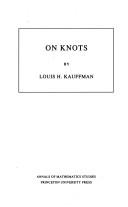
ISBN: 0691084343 0691084351 1400882133 9780691084343 Year: 1987 Volume: 115 Publisher: Princeton : Princeton University Press,
Abstract | Keywords | Export | Availability | Bookmark
 Loading...
Loading...Choose an application
- Reference Manager
- EndNote
- RefWorks (Direct export to RefWorks)
On Knots is a journey through the theory of knots, starting from the simplest combinatorial ideas--ideas arising from the representation of weaving patterns. From this beginning, topological invariants are constructed directly: first linking numbers, then the Conway polynomial and skein theory. This paves the way for later discussion of the recently discovered Jones and generalized polynomials. The central chapter, Chapter Six, is a miscellany of topics and recreations. Here the reader will find the quaternions and the belt trick, a devilish rope trick, Alhambra mosaics, Fibonacci trees, the topology of DNA, and the author's geometric interpretation of the generalized Jones Polynomial.Then come branched covering spaces, the Alexander polynomial, signature theorems, the work of Casson and Gordon on slice knots, and a chapter on knots and algebraic singularities.The book concludes with an appendix about generalized polynomials.
Knot theory --- Knots (Topology) --- Low-dimensional topology --- Knot theory. --- Algebraic topology --- 3-sphere. --- Addition theorem. --- Addition. --- Alexander polynomial. --- Algebraic variety. --- Algorithm. --- Ambient isotopy. --- Arf invariant. --- Basepoint. --- Bijection. --- Bilinear form. --- Borromean rings. --- Bracket polynomial. --- Braid group. --- Branched covering. --- Chiral knot. --- Chromatic polynomial. --- Cobordism. --- Codimension. --- Combination. --- Combinatorics. --- Complex analysis. --- Concentric. --- Conjecture. --- Connected sum. --- Conway polynomial (finite fields). --- Counting. --- Covering space. --- Cyclic group. --- Dense set. --- Determinant. --- Diagram (category theory). --- Diffeomorphism. --- Dimension. --- Disjoint union. --- Disk (mathematics). --- Dual graph. --- Elementary algebra. --- Embedding. --- Enumeration. --- Existential quantification. --- Exotic sphere. --- Fibration. --- Formal power series. --- Fundamental group. --- Geometric topology. --- Geometry and topology. --- Geometry. --- Group action. --- Homotopy. --- Integer. --- Intersection form (4-manifold). --- Isolated singularity. --- Jones polynomial. --- Knot complement. --- Knot group. --- Laws of Form. --- Lens space. --- Linking number. --- Manifold. --- Module (mathematics). --- Morwen Thistlethwaite. --- Normal bundle. --- Notation. --- Obstruction theory. --- Operator algebra. --- Pairing. --- Parity (mathematics). --- Partition function (mathematics). --- Planar graph. --- Point at infinity. --- Polynomial ring. --- Polynomial. --- Quantity. --- Rectangle. --- Reidemeister move. --- Remainder. --- Root of unity. --- Saddle point. --- Seifert surface. --- Singularity theory. --- Slice knot. --- Special case. --- Statistical mechanics. --- Substructure. --- Summation. --- Symmetry. --- Theorem. --- Three-dimensional space (mathematics). --- Topological space. --- Torus knot. --- Trefoil knot. --- Tubular neighborhood. --- Underpinning. --- Unknot. --- Variable (mathematics). --- Whitehead link. --- Wild knot. --- Writhe. --- Variétés topologiques --- Topologie combinatoire --- Theorie des noeuds
Book
ISBN: 0691145423 0691145415 9780691145419 9780691145426 1282645064 9786612645068 1400835402 9781400835409 Year: 2010 Publisher: Princeton : Princeton University Press,
Abstract | Keywords | Export | Availability | Bookmark
 Loading...
Loading...Choose an application
- Reference Manager
- EndNote
- RefWorks (Direct export to RefWorks)
Ramsey theory is a fast-growing area of combinatorics with deep connections to other fields of mathematics such as topological dynamics, ergodic theory, mathematical logic, and algebra. The area of Ramsey theory dealing with Ramsey-type phenomena in higher dimensions is particularly useful. Introduction to Ramsey Spaces presents in a systematic way a method for building higher-dimensional Ramsey spaces from basic one-dimensional principles. It is the first book-length treatment of this area of Ramsey theory, and emphasizes applications for related and surrounding fields of mathematics, such as set theory, combinatorics, real and functional analysis, and topology. In order to facilitate accessibility, the book gives the method in its axiomatic form with examples that cover many important parts of Ramsey theory both finite and infinite. An exciting new direction for combinatorics, this book will interest graduate students and researchers working in mathematical subdisciplines requiring the mastery and practice of high-dimensional Ramsey theory.
Algebraic spaces. --- Ramsey theory. --- Ramsey theory --- Algebraic spaces --- Mathematics --- Algebra --- Physical Sciences & Mathematics --- Spaces, Algebraic --- Geometry, Algebraic --- Combinatorial analysis --- Graph theory --- Analytic set. --- Axiom of choice. --- Baire category theorem. --- Baire space. --- Banach space. --- Bijection. --- Binary relation. --- Boolean prime ideal theorem. --- Borel equivalence relation. --- Borel measure. --- Borel set. --- C0. --- Cantor cube. --- Cantor set. --- Cantor space. --- Cardinality. --- Characteristic function (probability theory). --- Characterization (mathematics). --- Combinatorics. --- Compact space. --- Compactification (mathematics). --- Complete metric space. --- Completely metrizable space. --- Constructible universe. --- Continuous function (set theory). --- Continuous function. --- Corollary. --- Countable set. --- Counterexample. --- Decision problem. --- Dense set. --- Diagonalization. --- Dimension (vector space). --- Dimension. --- Discrete space. --- Disjoint sets. --- Dual space. --- Embedding. --- Equation. --- Equivalence relation. --- Existential quantification. --- Family of sets. --- Forcing (mathematics). --- Forcing (recursion theory). --- Gap theorem. --- Geometry. --- Ideal (ring theory). --- Infinite product. --- Lebesgue measure. --- Limit point. --- Lipschitz continuity. --- Mathematical induction. --- Mathematical problem. --- Mathematics. --- Metric space. --- Metrization theorem. --- Monotonic function. --- Natural number. --- Natural topology. --- Neighbourhood (mathematics). --- Null set. --- Open set. --- Order type. --- Partial function. --- Partially ordered set. --- Peano axioms. --- Point at infinity. --- Pointwise. --- Polish space. --- Probability measure. --- Product measure. --- Product topology. --- Property of Baire. --- Ramsey's theorem. --- Right inverse. --- Scalar multiplication. --- Schauder basis. --- Semigroup. --- Sequence. --- Sequential space. --- Set (mathematics). --- Set theory. --- Sperner family. --- Subsequence. --- Subset. --- Subspace topology. --- Support function. --- Symmetric difference. --- Theorem. --- Topological dynamics. --- Topological group. --- Topological space. --- Topology. --- Tree (data structure). --- Unit interval. --- Unit sphere. --- Variable (mathematics). --- Well-order. --- Zorn's lemma.
| Listing 1 - 10 of 12 | << page >> |
Sort by
|

 Search
Search Feedback
Feedback About
About Help
Help News
News